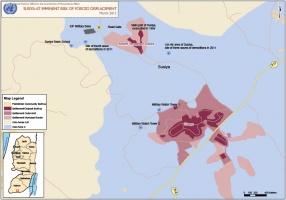 On 27 June, the Israeli Civil Administration (ICA) delivered 33 stop-work[1] orders and one demolition order to some residents of the Palestinian community of Sousiya, located in Area C, south-east Yatta, Hebron governorate. The stop-work orders regard 36 structures, including: 11 residential structures, 4 animal sheds, 4 water wells and a number of other structures used as kitchens or toilets. The demolition order regards a European Union-funded structure used as medical clinic and run by the Palestinian Ministry of Health. If these orders are implemented, 11 families totalling 70 people will be rendered homeless.
On 27 June, the Israeli Civil Administration (ICA) delivered 33 stop-work[1] orders and one demolition order to some residents of the Palestinian community of Sousiya, located in Area C, south-east Yatta, Hebron governorate. The stop-work orders regard 36 structures, including: 11 residential structures, 4 animal sheds, 4 water wells and a number of other structures used as kitchens or toilets. The demolition order regards a European Union-funded structure used as medical clinic and run by the Palestinian Ministry of Health. If these orders are implemented, 11 families totalling 70 people will be rendered homeless.
Since the early 1830s, the Sousiya community has lived in an area extending over 6,000 dunums of land (approximately 6,000,000 square metres). Since the 1980s, Sousiya has been the subject of several waves of demolitions by the Israeli authorities, thus exposing the Palestinian residents to the continuous threat of forcible transfer. In 1983, an outpost was established on Palestinian land in Sousiya. In 1986, the area was declared an archaeological site by the ICA and, as a result, the Israeli military expelled 60 families from Sousiya. In 2001, the Israeli military destroyed residents’ tents and other structures, forcing them to relocate to the surrounding area. In 2011, in four separate periods of demolitions, the Israeli army displaced 37 people and dismantled 41 structures in Um Nir area, eastern side of Sousiya.
Throughout the years, the Palestinian residents of Sousiya have repeatedly tried to apply for building permits but their applications have been systematically denied by the ICA. In addition, in the past when members of the community have begun building new tents and barracks to replace the homes that had previously been demolished, the ICA has issued demolition orders for the majority of the new structures. While the Palestinian community has faced repeated demolitions and forcible transfer, the Israeli settlement of ‘Suseya’ and other Israeli outposts have been established in the area and have steadily continued to expand.
In February 2012, the Zionist organisation Regavim petitioned the Israeli High Court of Justice (HCJ) requesting that it restricts the construction of new Palestinian structures around the settlement of ‘Suseya’. On 6 June 2012, the HCJ prohibited the construction of new structures by Palestinians in the area. Subsequently, on 12 June 2012, the ICA delivered notification of demolition orders for 70 Palestinian structures. The residents of Sousiya challenged the orders before the ICA. As of July 2013, the ICA has not yet taken a decision on the matter. As a result, the residents of Sousiya continue to live under the constant threat of having their homes demolished and being forcibly transferred.
Khaled Hammad Nawaj'a – Sousiya – Hebron Governorate
Khaled is a member of the Palestinian community of Sousiya. He lived with his family of 11 in two tents and also owned an animal shed and a cave that he used as a kitchen. In June 2012, ICA officers delivered a notification regarding the demolition of his tents and shed. Fearing that he would be rendered homeless, Khaled and his family relocated approximately 120 metres to the east of his structures.
Khaled's family is currently living in a 72-square-metre concrete structure divided in two rooms. Khaled also built a 15-square-metre structure that the family uses as kitchen, as well as a 100-square-metre shed for his sheep. Close by there is also a water well that collects up to 100 cubic metres of water.
On 27 June 2013, at approximately 9:30 am, officers from the ICA and Israeli soldiers delivered stop-work orders to the Palestinian residents of Sousiya, including Khaled who received three stop-work orders regarding his structures. The stop-work orders were issued on the basis of the Palestinian residents’ lack of building permits. Khaled and the other residents were informed that they could object the decision to demolish their structures before the ICA by 17 July. Consequently, they contacted the human rights organisation Rabbis for Human Rights, which had been previously involved in the case, and are consulting with them regarding the best strategy for objecting the orders. (Affidavit No. 8785/2013)
Khaled is one of the 250 Palestinians currently living in Sousiya. Their living conditions are extremely difficult due to the constant threat of forcible transfer and demolitions. Furthermore, the main sources of livelihood of the Palestinian community in Sousiya, herding and agriculture, have been significantly limited due to the appropriation of Palestinian land by Israel for settlement expansion. As a consequence, the Palestinian community can only access less than one third of the 6,000 dunums over which Sousiya extends.
Al-Haq reaffirms that Israel, as the Occupying Power in the Occupied Palestinian Territory, must comply with its obligations under international humanitarian and human rights law. Accordingly, Israel must safeguard the well-being and safety of the occupied Palestinian population, and guarantee the right to an adequate standard of living. Should the Israeli military carry out further demolitions, the Palestinian community of Sousiya will be forced to relocate again in the surrounding area or leave the village. Al-Haq condemns the Israeli policies carried out in this area that might result in the Palestinian community’s forcible transfer, which amounts to a grave breach of the Fourth Geneva Convention and a war crime.
[1] Palestinians receive a ‘stop-work’ order when they build a structure without a building permit from the ICA. As it is virtually impossible to obtain any permit, Palestinians build their homes, wells and other structures. At the same time they try to apply for permits. The ‘stop-work’ order informs the owner of a structure that it will be demolished unless he objects the decision. Palestinians try to challenge such decisions, but their objections are always rejected by the ICA, which then delivers a demolition order. Finally when the demolition order is delivered, the actual demolition will be carried out.



 On 27 June, the Israeli Civil Administration (ICA) delivered 33 stop-work
On 27 June, the Israeli Civil Administration (ICA) delivered 33 stop-work